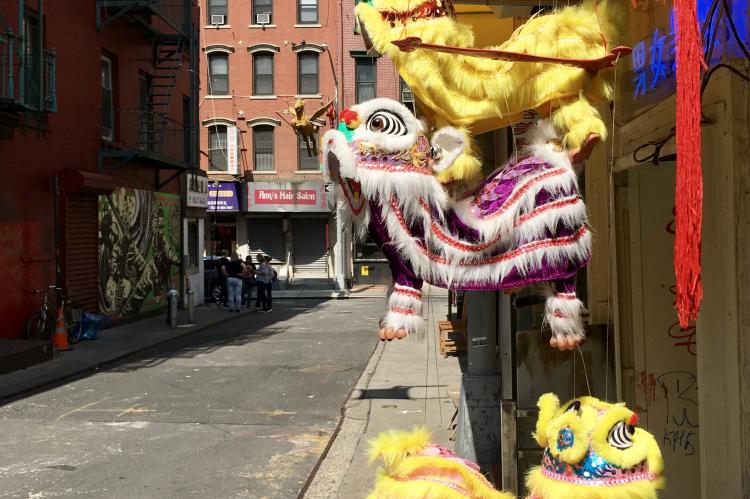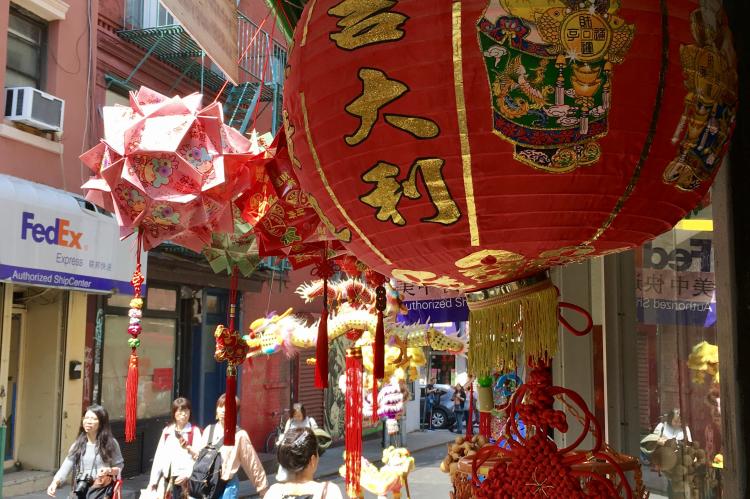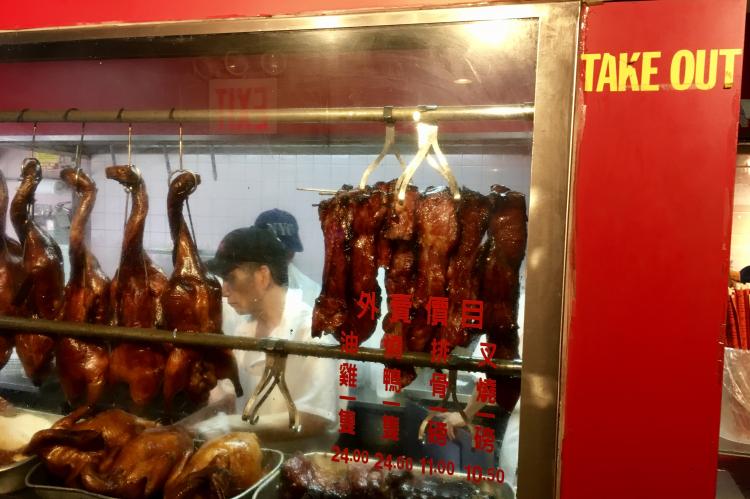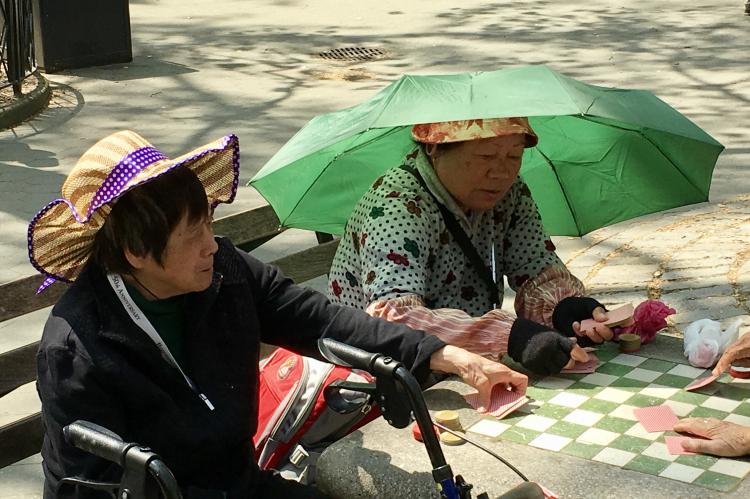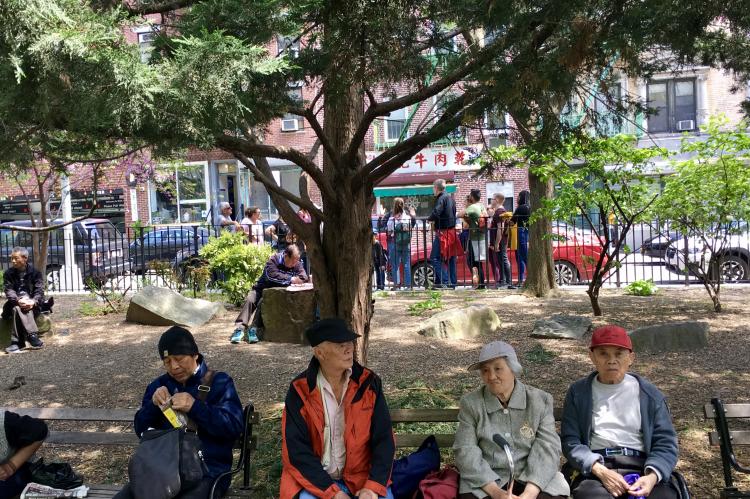Emerge from the subway on Canal Street in Chinatown, New York City, and be prepared for a wonderfully chaotic assault to the senses. Wizened grannies haggle loudly over all kinds of unrecognizable goods, younger women step into your path, whispering, “Handbag, Rolex, perfume.” Buckets of eels and brilliant blue crabs spill onto the sidewalk as customers clamor over fresh prawns and whole fish. Peking ducks hang in restaurant windows with skin like glass and the color of Chippendale mahogany. Inside Double Crispy Bakery on Grand Street, crowds gather around shelves stuffed with buns, dan ta (egg custards), and lao po bing (wife cakes). The doors swing open every few seconds as people emerge clutching brown paper bags, the smell of freshly baked dough following behind them. There’s another smell, too: the pungent aromas from the traditional medicine shops selling giant sponge-like mushrooms, dried ginseng, and licorice root. On tiny Pell Street, there’s an absurd number of hairdressers and barbershops, as well as private kung fu clubs that train in secrecy; if you’re not Chinese, or even an A.B.C. (American-born Chinese), you might not be welcome. If you can remember to, look up and see the beautiful painted balconies on buildings that were the former headquarters of the feuding Tong gangs. Swing around the bend onto Doyers Street, once nicknamed “the bloody angle” after the carnage spilled by the Tongs, and suddenly, away from the bustle of it all, time seems to stand still.
with signs up on the wall written in Chinese, it’s generally believed that there are secret menus accessible only to Cantonese speakers
Chinatown remains an oasis of whimsy, mystery, and grit in a city slowly muted by homogeneity. Its two square miles make it the largest Chinatown in the United States and home to the heaviest concentration of Chinese in the western hemisphere.
The biggest myth about Chinatown is that the Chinese are unwilling to assimilate, that they tend to stick together more than any other group of immigrants in an adopted country. Walking through the streets, someone unfamiliar with the culture can feel like a foreigner — even the neighborhood banks have unfamiliar names, like Abacus and Eastbank — but the real story is not one of a reluctant embrace of America but one of American xenophobia.
In the 1880s, many Americans resented immigrants’ willingness to work for less money and in poorer conditions than native-born workers, and so, in 1882, Congress passed the Chinese Exclusion Act, which barred unskilled Chinese workers from entering the U.S. Most horribly, the act prohibited the wives and children of Chinese workmen living in the U.S. from joining them. This led to Chinatown being nicknamed “the bachelor society,” and rumors of opium dens and prostitution only fueled antagonism toward the group. Given such hostility, an underground economy emerged, allowing undocumented Chinese laborers to work illegally as long as they stayed within the confines of Chinatown. Slowly, the area evolved as a sort of racial ghetto with an internal structure of governing associations and businesses, supplying jobs, economic aid, and protection for Chinese immigrants.
Today’s Chinatown still possesses a rhythm all its own and it’s one of my favorite places in which to spend a few hours when in the city.
My first stop is always for roast duck at Big Wong on Mott Street, a cash-only, old-school Cantonese joint. The roasted bird, with its fatty, succulent meat and crackly, burnished skin, can be enjoyed over rice or congee (rice porridge). There’s a mix of tourists and neighborhood denizens here, but with signs up on the wall written in Chinese, it’s generally believed that there are secret menus accessible only to Cantonese speakers.
The Nom Wah Tea Parlor on Doyers Street offers some of the best dim sum around. Opened in 1920, Nom Wah is the oldest restaurant in the neighborhood. The pork buns are splendid, as are the O.G. egg rolls: an egg crepe rolled in a homemade batter, stuffed with chicken and mixed veggies, and then fried. And, although I haven’t been brave enough to try them yet, the chicken feet are said to be the best in the city. Down on pretty Mosco Street is Fried Dumplings, where the meanest businesswoman in town serves up the best dumplings at $1.25 for five.

In China, it is said, firewood, rice, oil, salt, sauce, vinegar, and tea are considered the seven necessities to begin a day. No place takes tea, and the art of Chinese tea drinking, more seriously than Sun’s Organic Garden on Bayard Street. Well-stacked shelves boast more than 1,000 loose-leaf varieties from around the world, as well as herbal remedies purported to aid digestion, brain function, sinus drainage, and women’s wellness. Sun’s is famous for its oolong teas, including one of the rarest, DaYuLing, grown at extremely high elevations and sold for around $20 an ounce; each batch of leaves holds enough flavor for up to eight steeps.
The nearby Museum of Chinese in America, on Centre Street, is a wonderful place to learn more about the history of Chinatown and its people. Founded in 1980, the space was expanded and redesigned by the architect Maya Lin, showcasing historical and political photographs, first person stories, and films. A few artifacts on display also help us understand the immigrants’ struggles and hardships, such as a cap-gun toy from the 1880s: When the trigger is pulled, a suited gentleman kicks a braided Chinese man in the rear, setting off a miniature explosion.
But perhaps the loveliest spot around is leafy Columbus Park, surrounded by Baxter, Worth, Bayard, and Mulberry Streets. It serves as Chinatown’s communal backyard, in the middle of which stands a statue of Dr. Sun Yat-sen, the first president of the Republic of China. Men and women arrive in the early morning hours to practice tai chi. By lunchtime, lawyers and jurors from the nearby Criminal Court building mingle with the crowd as older ladies, crouched on low stools under rainbow-hued umbrellas, wait to tell the fortunes of passers-by. Sometimes, a small Chinese opera troupe or musicians with traditional Chinese instruments will perform under the shade of a tree. And all day long, around every table in the park, women congregate to play cards while men compete in intense games of Xiangqi, or Chinese chess.
How is it possible that one of the most desirable tracts of real estate in Manhattan is still primarily a low-income neighborhood, its storefronts still dominated by mom-and-pop operations, its internal economy continuing to hum? Developers would eagerly replace Chinatown’s lanky tenement buildings with pricey apartment towers for young professionals, reducing Chinatown to an ethnic theme park like those in Chicago, Boston, Philadelphia, and Washington D.C.
Built on the graveyards of enclaves past — the Irish Five Points, the Jewish Lower East Side, and Little Italy — Chinatown manages to resist. For how much longer, no one knows. Until then, it remains a lovely, iconic reminder of New York’s immigrant history.


